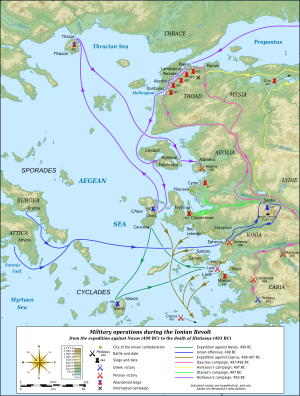
Back Ioniese Opstand Afrikaans Ionischer Aufstand ALS الثورة الإيونية Arabic ایون آیاقلانماسی AZB Йонийско въстание Bulgarian Revolta Jònica Catalan Iónské povstání Czech Ionischer Aufstand German Ιωνική Επανάσταση Greek Revuelta jónica Spanish
| Ionian Revolt | |||||||
|---|---|---|---|---|---|---|---|
| Part of the Greco-Persian Wars | |||||||
 Location and main events of the Ionian Revolt. | |||||||
| |||||||
| Belligerents | |||||||
| Achaemenid Empire | |||||||
| Commanders and leaders | |||||||
The Ionian Revolt, and associated revolts in Aeolis, Doris, Cyprus and Caria, were military rebellions by several Greek regions of Asia Minor against Persian rule, lasting from 499 BC to 493 BC. At the heart of the rebellion was the dissatisfaction of the Greek cities of Asia Minor with the tyrants appointed by Persia to rule them, along with the individual actions of two Milesian tyrants, Histiaeus and Aristagoras. The cities of Ionia had been conquered by Persia around 540 BC, and thereafter were ruled by native tyrants, nominated by the Persian satrap in Sardis. In 499 BC, the tyrant of Miletus, Aristagoras, launched a joint expedition with the Persian satrap Artaphernes to conquer Naxos, in an attempt to bolster his position. The mission was a debacle, and sensing his imminent removal as tyrant, Aristagoras chose to incite the whole of Ionia into rebellion against the Persian king Darius the Great.
In 498 BC, supported by troops from Athens and Eretria, the Ionians marched on, captured, and burnt Sardis. However, on their return journey to Ionia, they were followed by Persian troops, and decisively beaten at the Battle of Ephesus. This campaign was the only offensive action by the Ionians, who subsequently went on the defensive. The Persians responded in 497 BC with a three pronged attack aimed at recapturing the outlying areas of the rebellion, but the spread of the revolt to Caria meant that the largest army, under Daurises, relocated there. While initially campaigning successfully in Caria, this army was annihilated in an ambush at the Battle of Pedasus. This battle had started a stalemate for the rest of 496 BC and 495 BC.
By 494 BC the Persian army and navy had regrouped, and they made straight for the epicentre of the rebellion at Miletus. The Ionian fleet sought to defend Miletus by sea, but was decisively beaten at the Battle of Lade, after the defection of the Samians. Miletus was then besieged, captured, and its population was brought under Persian rule. This double defeat effectively ended the revolt, and the Carians surrendered to the Persians as a result. The Persians spent 493 BC reducing the cities along the west coast that still held out against them, before finally imposing a peace settlement on Ionia which was generally considered to be both just and fair.
The Ionian Revolt constituted the first major conflict between Greece and the Persian Empire, and as such represents the first phase of the Greco-Persian Wars. Although Asia Minor had been brought back into the Persian fold, Darius vowed to punish Athens and Eretria for their support of the revolt. Moreover, seeing that the myriad city states of Greece posed a continued threat to the stability of his Empire, according to Herodotus, Darius decided to conquer the whole of Greece. In 492 BC, the first Persian invasion of Greece, the next phase of the Greco-Persian Wars, began as a direct consequence of the Ionian Revolt.